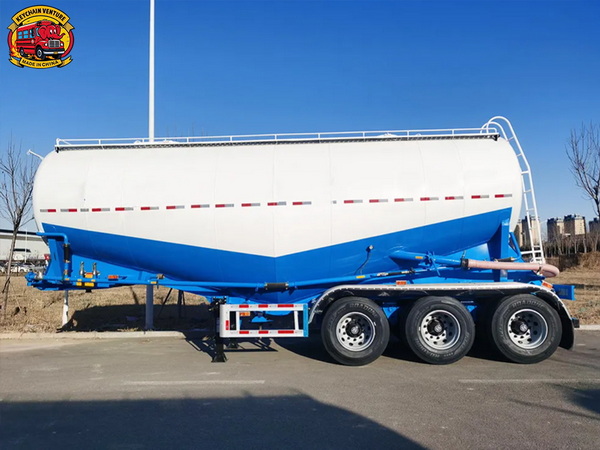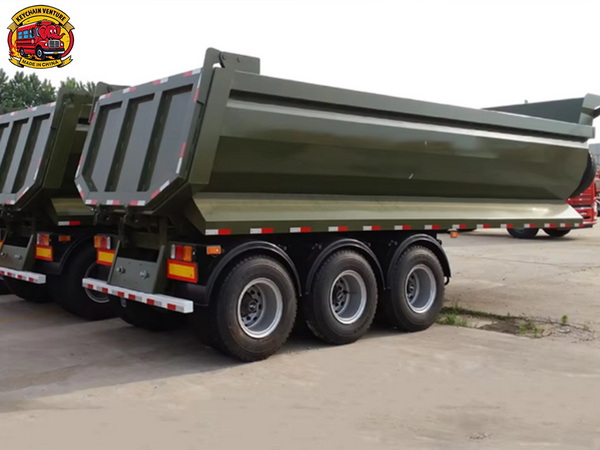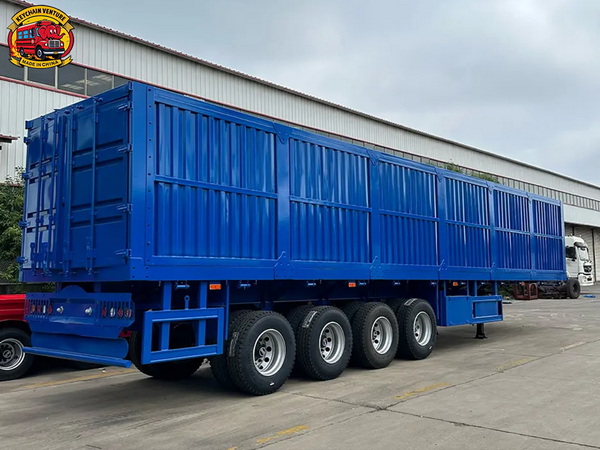Views: 222 Author: Amanda Publish Time: 2025-11-06 Origin: Site








Content Menu
● Understanding the Semi Trailer and Bale Types
● Bale Characteristics and Their Impact on Capacity
● Typical Semi Trailer Dimensions and How They Relate to Hay
● Estimating Bale Capacity: A Practical Approach
● Loading Scenarios: Small vs. Large Bales
● Loading Techniques and Best Practices
● Practical Capacity Ranges (Illustrative Estimates)
● Safety, Compliance, and Operational Considerations
● The Role of Trailer Design in Efficiency
● FAQ
>> 1. How does bale size affect the number of bales that fit on a semi trailer?
>> 2. Can a flatbed trailer carry more hay than a dry van?
>> 3. What are the typical GVW constraints to consider when loading hay?
>> 4. Are there recommended loading patterns for stability?
>> 5. What safety practices should accompany hay loading on semi trailers?
KeyChain Venture Co., Ltd. is a leading Chinese supplier of high-performance commercial vehicles, specializing in coaches and heavy trucks for both domestic and international markets. This article provides a comprehensive guide to understanding how many bales of hay can fit in a semi trailer, covering bale types, trailer dimensions, loading strategies, and practical considerations for maximizing payload and safety.

A Semi Trailer is a large, highway-capable platform designed to be towed by a tractor unit. In the context of hay transport, the most common Semi Trailer is the standard 53-foot dry van, though flatbeds and specialized trailers are also used depending on the bale type and route requirements. The Semi Trailer's dimensions and weight capacity are critical factors in determining how many bales can be loaded per trip.[1][3]
Hay bales come in several standard shapes and sizes, including small square bales, large square bales, and round bales. Each type has distinct dimensions and weight, which directly affect how many can be stowed in a Semi Trailer. For example, small square bales are typically 14 inches by 18 inches by 36 inches, while large square bales can be 3 feet by 3 feet by 8 feet, and round bales often have a diameter of 4 feet. The choice of bale type influences stacking patterns, loading efficiency, and overall payload.[6][1]
The size and weight of hay bales are the primary determinants of how many can fit in a Semi Trailer. Small square bales are lighter and more compact, allowing for denser packing and higher counts per load. Large square and round bales are heavier and bulkier, reducing the total number that can be loaded but often simplifying handling and securing.[2][1]
Bale shape also plays a crucial role in stacking efficiency. Square bales can be stacked in uniform rows, maximizing space utilization and stability. Round bales, due to their cylindrical shape, require careful placement to prevent rolling and shifting during transit. The geometry of the bales affects how tightly they can be packed and how secure they remain under various road conditions.[1]
Material and moisture content further influence bale weight and density. Bales with higher moisture content are heavier and may require adjustments to loading plans to avoid exceeding weight limits. Understanding these variables helps ensure that each load is optimized for both volume and weight.[1]
The standard Semi Trailer used for hay transport is typically 53 feet long, 8.5 feet wide, and has an interior height of about 9 to 10 feet. These dimensions provide a substantial load area for stacking bales, but the actual usable space can be affected by the presence of pallets, dunnage, and securing equipment.[2][1]
Trailer types vary, with dry vans offering enclosed protection and flatbeds providing greater flexibility for stacking and securing. Lowboy trailers are used for oversized or tall loads, allowing for higher stacking but requiring careful weight and route planning. Each trailer type has its own advantages and limitations, and the choice depends on the specific requirements of the hay transport operation.[10][1]
Weight limits are a critical consideration when loading hay onto a Semi Trailer. Highway and bridge-allowable gross vehicle weight (GVW) limits constrain how many bales can be carried per trip. For many regions, the GVW cap plus tractor weight sets a hard ceiling on bale counts, regardless of available volume. Ensuring compliance with these limits is essential for safety and regulatory compliance.[3][7]
To estimate how many bales of hay can fit in a Semi Trailer, follow these steps:
1. Determine Bale Dimensions and Weight: Gather consistent measurements for your typical bale inventory (height, width, length, and weight). This foundation anchors all capacity calculations.[2][1]
2. Calculate Usable Trailer Volume: For a 53-foot dry van, calculate the interior length, width, and height, then subtract space taken by pallets, dunnage, and securing equipment. This yields the gross usable volume for bales.[1][2]
3. Model Stacking Patterns: Depending on bale geometry, test several configurations (e.g., column stacks, interlocked rows) to maximize payload while maintaining safe load distribution and access for inspection.[1]
4. Check Weight Distribution: Ensure that front-rear and side-to-side weight distribution avoids overloading axles and complies with axle weight limits. The heaviest portion of the load should be supported by the drive axle as appropriate for traction and stability.[7][3]
5. Validate Legal and Safety Constraints: Confirm that the total vehicle weight, dimension limits, and securing methods align with local regulations and industry safety standards.[3][10]

Small Square Bales: Typically denser packing possible due to their uniform shape; stacking efficiency can be high, allowing more bales per trailer length when the weight per bale stays within GVW limits. Container-like packing can minimize gaps but requires precise tying and securing.[2][1]
Large Square and Round Bales: May reduce the total count but can improve handling speed and stability with appropriate strapping and side protection. Height and width constraints become the primary determinants of how many can be loaded.[1]
Mixed-Bale Strategies: In some fleets, mixing bale types helps balance space utilization with weight distribution, but this requires careful planning and consistent securing procedures to prevent shifting.[1]
Use of Dunnage and Air Gaps: Properly placed dunnage and carefully managed gaps can improve stacking stability and prevent movement during transit. Balance is key to avoiding concentrated stress on any single point of the trailer deck.[1]
Securing Methods: Tarps, straps, ratchet ties, and load bars should be selected based on bale type and trailer design. Enforce uniform tie-down patterns to minimize shifting risk in turns and braking events.[1]
Loading Sequence: Begin with heavier or larger bales at one end and work toward the opposite end to maintain level weight distribution and simplify unloading at destination. Adapt sequences for trailers with multiple tiers or shelves.[1]
Note: Real-world capacity will vary with bale dimensions, trailer type, route, and regulatory limits. Use these illustrative ranges as starting benchmarks and customize with your fleet data.
- Standard 53-foot dry van with small to mid-size square bales: Depending on bale size and weight, a typical full load could range from several hundred to around a thousand bales, adjusted for GVW and height constraints.[2][1]
- Large square bales on a 53-foot trailer: Fewer bales per load due to higher individual volume, but quicker offloading with appropriate securing. Expect a lower count than small bales while maintaining equivalent total bale mass.[1]
- Round bales on a flatbed: A flatbed's open sides allow flexible stacking and may yield different counts; careful securing is essential to prevent rolling or shifting.[10]
Weight Compliance: Always verify GVW and axle weight limits for the specific corridor, state/province, and country of operation. Exceeding limits can lead to fines, road damage, and safety hazards.[7][3]
Roadside Inspections: Preparedness for inspections includes securing inventory, having documentation for bale dimensions and weights, and a clear unloading plan.[3]
Weather and Environmental Controls: Hay bales are susceptible to moisture and mold; consider cover strategies and drainage when operating open trailers.[10]
Trailer Height and Interior: Higher interior clearances can enable stacking more bales per layer, subject to weight limits and structural integrity. Understanding dealer-specified interior dimensions helps optimize loading.[1]
Doors and Access Points: Wide doors or tailgates simplify loading/unloading and reduce handling time, contributing to overall efficiency.[10]
Tie-down System Integration: Integrated securing points engineered into trailer design can streamline the loading process and improve safety margins.[10]
Maximizing the number of hay bales on a Semi Trailer involves a careful balance of bale dimensions, trailer geometry, and weight restrictions. By standardizing bale sizes for planning, selecting the appropriate trailer type, and adopting repeatable loading and securing practices, fleets can achieve greater transport efficiency without compromising safety or regulatory compliance. The approach outlined here—grounded in trailer dimensions, bale geometry, loading patterns, and securement—helps logistics teams optimize payload, reduce trips, and lower per-bale transportation costs. For KeyChain Venture Co., Ltd., these insights can inform customer-ready configurations and practical deployment of high-performance Semi Trailer solutions across domestic and international markets.

Larger bales take more space and weigh more, reducing the total count but potentially simplifying handling and securing. Smaller bales often allow denser packing, increasing count within GVW limits.[1]
A flatbed may offer more flexible stacking options but requires careful securing and weather protection; the actual count depends on bale size, weight, and interior dimensions.[10]
GVW limits vary by country and route; ensure total trailer plus load weight complies with axle and bridge standards to avoid penalties and safety risks.[7][3]
Front-to-back and side-to-side weight balance, along with uniform tie-down placements, improve stability and reduce shifting during transit.[1]
Use appropriate dunnage, securement, moisture protection, and weather-aware planning to protect cargo and ensure compliant operation.[3][10]
[1](https://semitrailer.by/how-many-bales-of-hay-fit-on-a-semi-trailer-understanding-capacity-and-transportation/)
[2](https://semitrailer.by/optimizing-space-how-many-small-square-bales-fit-on-a-semi-trailer/)
[3](https://semitrailer.by/how-many-bales-of-hay-fit-on-a-semi-trailer-a-comprehensive-guide/)
[4](https://heavyhaulandoversized.com/process/hay-transport/)
[5](https://www.feedcentral.com.au/hay-straw-silage-truck-trailer-sizes/)
[6](https://www.tractortransport.com/blog/hay-bale-types-and-how-many-fit-on-a-trailer/)
[7](https://ops.fhwa.dot.gov/freight/policy/rpt_congress/truck_sw_laws/app_a.htm)
[8](https://cookfeedandoutdoor.com/pages/hay-purchasing)
[9](https://www.facebook.com/groups/SmallFarm/posts/10157493279973065/)
[10](https://tractortransport.com/transporting_hay.php)